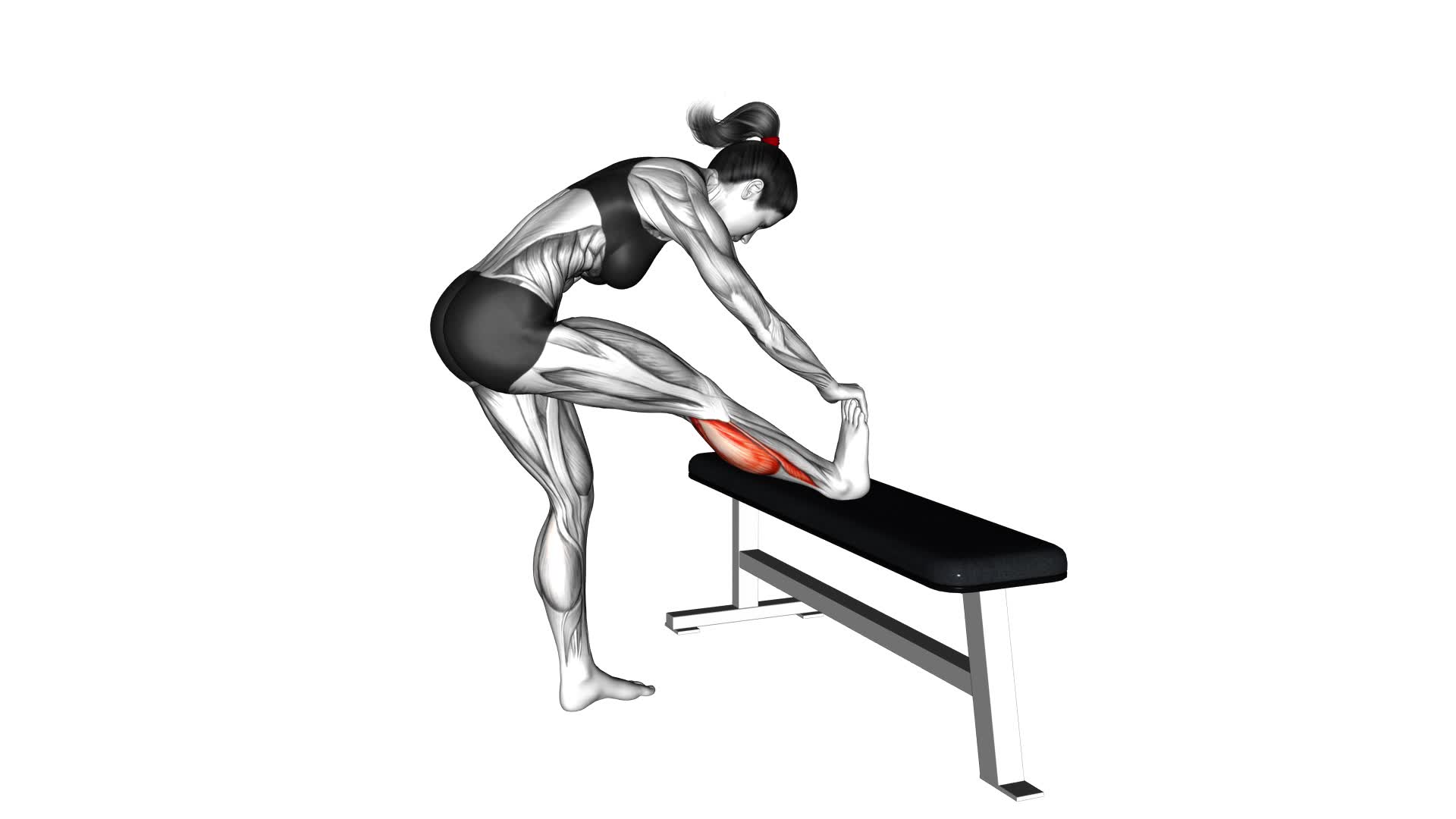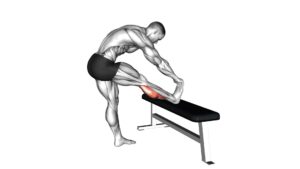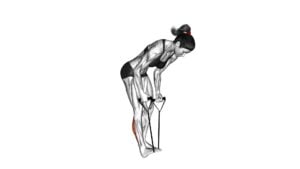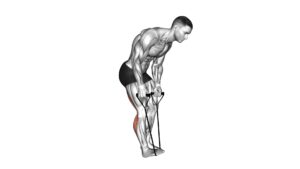Standing Gastrocnemius Calf Stretch (female) – Video Exercise Guide & Tips

Are you looking to improve flexibility and range of motion in your calves?
Watch This Exercise Video
Then the Standing Gastrocnemius Calf Stretch is perfect for you!
In this video exercise guide, we'll show you the proper form and technique specifically designed for females.
With helpful tips and modifications for all skill levels, you'll be able to avoid potential mistakes and achieve optimal results.
Get ready to stretch and strengthen your calf muscles with this effective exercise.
Key Takeaways
- The standing gastrocnemius calf stretch increases flexibility of calf muscles and promotes muscle recovery after physical activity.
- Proper form and technique for females include standing facing a wall, placing hands on the wall for support, and bending the knee slightly to feel the stretch in the calf.
- Modifications for females include starting with a smaller step back, performing the stretch on a slight incline, and raising toes off the ground to intensify the stretch.
- Tips for increasing flexibility and range of motion include incorporating dynamic stretching, using static stretching after workouts, foam rolling, avoiding overstretching, and gradually increasing flexibility.
Benefits of the Standing Gastrocnemius Calf Stretch
To fully understand the benefits of the Standing Gastrocnemius Calf Stretch, it's important that you learn about the various ways it can improve your overall flexibility and prevent injuries. This stretch not only helps to increase the flexibility of your calf muscles, but it also promotes better muscle recovery after intense physical activity.
One of the major health benefits of the Standing Gastrocnemius Calf Stretch is improved flexibility. By regularly performing this stretch, you can increase the range of motion in your calf muscles, allowing for better movement and preventing muscle imbalances. This increased flexibility can also help to alleviate muscle tightness and reduce the risk of muscle strains and tears.
In addition to enhancing flexibility, this stretch is also beneficial for muscle recovery. After a strenuous workout, your calf muscles can become tight and fatigued. The Standing Gastrocnemius Calf Stretch helps to elongate these muscles, promoting blood flow and oxygen delivery to the area. This increased blood flow aids in the removal of waste products and promotes the delivery of essential nutrients to the muscles, helping them to recover more efficiently.
Incorporating the Standing Gastrocnemius Calf Stretch into your regular exercise routine can have significant benefits for your overall flexibility and muscle recovery. By taking the time to perform this stretch, you can improve your overall health and reduce the risk of injury during physical activity.
Proper Form and Technique for Females
You can achieve proper form and technique for the Standing Gastrocnemius Calf Stretch as a female by following these guidelines:
- Stand facing a wall or sturdy object, with your feet hip-width apart.
- Place your hands on the wall at shoulder height for support.
- Step your right foot back, keeping it straight and your heel on the ground.
- Bend your left knee slightly, and lean forward, feeling a stretch in your right calf.
To ensure proper form and technique as a female, it's important to consider your specific flexibility level and make modifications accordingly. Female flexibility can vary, so here are some calf stretch modifications to keep in mind:
- If you're less flexible, start with a smaller step back and gradually increase the distance as your flexibility improves.
- If you have tight calves or experience pain during the stretch, try performing the stretch on a slight incline, such as using a step or curb.
- If you have particularly flexible calf muscles, you can intensify the stretch by raising your toes off the ground while keeping your heel down.
By following these guidelines and making appropriate modifications, you can ensure that you're performing the Standing Gastrocnemius Calf Stretch with proper form and technique as a female. This will help maximize the benefits and minimize the risk of injury.
Now, let's move on to the next section for tips on increasing flexibility and range of motion.
Tips for Increasing Flexibility and Range of Motion
To increase flexibility and range of motion, incorporate these tips into your routine.
Improving muscle elasticity is essential for achieving greater flexibility. One effective stretching technique is dynamic stretching. This involves moving your joints and muscles through a full range of motion in a controlled manner. Dynamic stretching can help warm up your muscles and improve their elasticity before engaging in more intense activities.
Another technique to consider is static stretching. This involves holding a stretch for a prolonged period, usually around 30-60 seconds. Static stretching helps to lengthen and relax the muscles, increasing your range of motion. It's important to note that static stretching should be done after your workout or physical activity, as it can temporarily decrease muscle strength if performed before.
Additionally, incorporating foam rolling into your routine can further enhance flexibility. Foam rolling helps to release tension and tightness in the muscles, allowing for improved elasticity and range of motion.
Remember to always listen to your body and avoid overstretching, as this can lead to injury. By incorporating these effective stretching techniques into your routine, you can gradually increase your flexibility and range of motion.
Modifications for Beginners and Advanced Practitioners
As you progress in your flexibility and range of motion journey, it's important to understand the modifications available for both beginners and advanced practitioners. Whether you're just starting out or have been practicing for a while, these modifications can help you tailor the standing gastrocnemius calf stretch to your current level of ability.
Here are some beginner modifications to consider:
- Use a support: If you're having difficulty balancing, use a wall or a sturdy chair to support yourself while performing the stretch.
- Bend your knee: For those with tight calf muscles, bending the knee of the leg being stretched can help alleviate some of the tension.
- Decrease range of motion: Start with a smaller movement and gradually increase the stretch as your flexibility improves.
- Perform seated stretch: If standing is too challenging, try performing the stretch in a seated position with your leg extended.
For advanced practitioners looking to deepen their stretch, here are some modifications to try:
- Increase duration: Hold the stretch for a longer period of time, aiming for 30 seconds to 1 minute.
- Add resistance: Use a resistance band or towel to provide additional resistance as you stretch.
- Perform on an elevated surface: Place the ball of your foot on a step or sturdy block to increase the intensity of the stretch.
- Incorporate dynamic movements: Add movement to the stretch by gently bouncing or pulsing in and out of the stretched position.
Potential Mistakes to Avoid for Optimal Results
One potential mistake to avoid for optimal results in the standing gastrocnemius calf stretch is improper foot positioning. Many people mistakenly believe that the feet should be parallel during this stretch, but this is a common misconception. In reality, the foot that's being stretched should be turned slightly inward, while the other foot remains in a neutral position. This allows for a deeper stretch of the gastrocnemius muscle, which is the main target of this exercise.
Another common error is failing to maintain proper alignment of the ankle, knee, and hip joints. It's important to ensure that these joints are stacked on top of each other to avoid any unnecessary strain or risk of injury. Additionally, some individuals may inadvertently lean forward or backward while performing this stretch, which can compromise its effectiveness. To prevent this, focus on maintaining an upright posture throughout the exercise, with the shoulders relaxed and the core engaged.
Lastly, rushing through the stretch or not holding it for long enough is a common mistake. The gastrocnemius calf stretch should be held for at least 30 seconds on each side to allow the muscles to fully elongate and relax. By avoiding these common errors and misconceptions, you can maximize the benefits of the standing gastrocnemius calf stretch and achieve optimal results.
Frequently Asked Questions
How Long Should I Hold the Stretch for Optimal Results?
To achieve optimal results, it's important to hold the stretch for an appropriate duration. The optimal duration for the standing gastrocnemius calf stretch can vary depending on your fitness level and flexibility.
However, a general guideline is to hold the stretch for about 30 seconds to one minute. This allows enough time for the muscle to lengthen and improve flexibility.
Remember to maintain proper stretching technique, keeping your back straight and feeling a gentle pull in the calf muscle.
Can This Stretch Help With Plantar Fasciitis?
Stretching the gastrocnemius calf muscle can provide several benefits for plantar fasciitis relief. By targeting the calf muscle, this stretch helps to lengthen and loosen the tight muscles that can contribute to plantar fasciitis pain.
However, it's important to note that this stretch alone may not be enough to fully manage plantar fasciitis. It's recommended to incorporate other effective stretches, such as the plantar fascia stretch or the toe stretch, to further alleviate symptoms and promote healing.
Is It Safe to Perform This Stretch if I Have a Previous Calf Injury?
If you have a previous calf injury, it's important to take precautions when performing the Standing Gastrocnemius Calf Stretch. Make sure to start with gentle movements and listen to your body.
If you experience any pain or discomfort, stop immediately and consult with a healthcare professional. It may be helpful to explore alternative calf stretches that are less intense and provide more support for your injury.
Always prioritize your safety and recovery.
Can I Do This Stretch if I Have Knee Pain?
If you're experiencing knee pain, it's important to listen to your body and make modifications during calf stretching exercises.
Knee pain can be a sign of an underlying issue, so it's best to consult with a healthcare professional before attempting any stretches.
They can provide you with specific modifications or alternative exercises that will be safe and effective for you.
Are There Any Variations of This Stretch That Target Different Muscles in the Calf?
When it comes to calf stretches, there are indeed different variations that target various muscles in the calf. These variations can help you achieve a well-rounded lower body stretching routine.
By incorporating the standing gastrocnemius calf stretch into your routine, you can specifically target the gastrocnemius muscle in your calf. This stretch is effective in improving flexibility and preventing injuries.
Remember to always warm up before stretching and listen to your body to avoid any pain or discomfort.
Conclusion
Incorporating the standing gastrocnemius calf stretch into your exercise routine can bring numerous benefits, including improved flexibility and range of motion.
By following the proper form and technique, females can effectively stretch their calves and avoid potential mistakes that may hinder their results.
Whether you're a beginner or an advanced practitioner, modifications are available to suit your level of experience.
By consistently practicing this stretch, you'll be well on your way to achieving optimal results and maintaining healthy calf muscles.

Author
Years ago, the spark of my life’s passion ignited in my mind the moment I stepped into the local gym for the first time. The inaugural bead of perspiration, the initial endeavor, the very first surge of endorphins, and a sense of pride that washed over me post-workout marked the beginning of my deep-seated interest in strength sports, fitness, and sports nutrition. This very curiosity blossomed rapidly into a profound fascination, propelling me to earn a Master’s degree in Physical Education from the Academy of Physical Education in Krakow, followed by a Sports Manager diploma from the Jagiellonian University. My journey of growth led me to gain more specialized qualifications, such as being a certified personal trainer with a focus on sports dietetics, a lifeguard, and an instructor for wellness and corrective gymnastics. Theoretical knowledge paired seamlessly with practical experience, reinforcing my belief that the transformation of individuals under my guidance was also a reflection of my personal growth. This belief holds true even today. Each day, I strive to push the boundaries and explore new realms. These realms gently elevate me to greater heights. The unique combination of passion for my field and the continuous quest for growth fuels my drive to break new ground.







